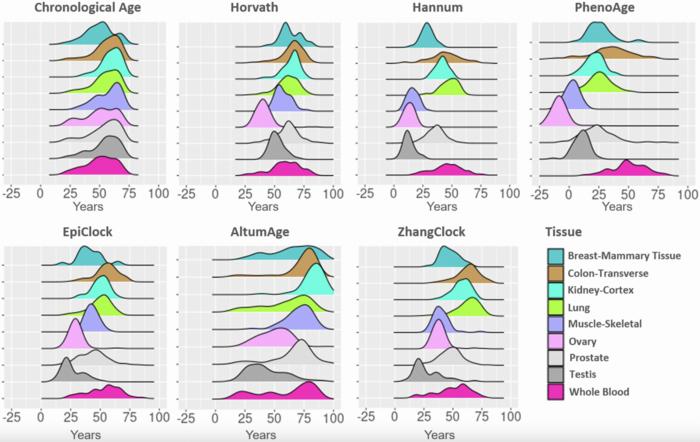
Researchers Mark Richardson and his team from the University of Chicago and the University of Pittsburgh recently published a groundbreaking study in the journal Aging that sheds new light on the reliability of DNA methylation clocks used for determining biological age across various human tissue types. Their findings suggest significant discrepancies in the accuracy of these methylation-based aging predictions when applied to non-blood tissues, paving the way for future research that may drastically reshape our understanding of biological aging.
DNA methylation clocks are vital tools in forensic science and longevity research because they offer estimates of biological age by examining chemical alterations in DNA. These epigenetic markers reflect an individual’s life experiences and environmental interactions, enabling scientists to predict age-related diseases and evaluate the impact of lifestyle choices on aging processes. Historically, most methylation clocks were developed using blood samples, raising questions about their applicability to other tissues.
In their investigation, the researchers tested a total of eight different DNA methylation clocks across nine distinct human tissue types, including the lungs, kidneys, and reproductive organs. Their method involved a thorough analysis of 973 tissue samples derived from the Genotype-Tissue Expression (GTEx) project, ensuring a robust dataset for their comparative analysis. This comprehensive study allowed them to observe how age estimates varied not only among different tissues but also within tissue types themselves.
The results from their research were intriguing. The analysis revealed that blood samples provided the most consistent and reliable age estimates across all clocks examined. In stark contrast, samples from the lungs and colon frequently indicated age estimates that were markedly older than expected, while samples from testis and ovary tissues often appeared biologically younger. These findings challenge the long-held assumption that epigenetic aging occurs uniformly across all tissues, suggesting that aging may proceed at different rates in different organs of the body.
This research highlights that existing methylation clocks trained solely on blood-derived samples, such as the Hannum clock, exhibited the most pronounced discrepancies in age estimates when applied to other tissues. Even clocks designed for broader applicability, like the Horvath clock, demonstrated significant variability when subjected to diverse tissue types. Such variances underline the necessity for developing new organ-specific epigenetic clocks that could deliver more accurate biological age predictions tailored to each tissue’s unique biological environment and aging mechanisms.
The researchers argue that creating tissue-specific aging clocks could not only refine biological age predictions but also enhance the effectiveness of medical diagnostics and strategies for age-related disease prevention. By accurately assessing the biological age of different tissues, clinicians might utilize these insights to devise targeted interventions that could help mitigate age-related health risks and improve overall longevity.
Significantly, although the study laid the groundwork for future explorations, it also underscored the critical requirement for larger sample sizes and more comprehensive data on tissue-specific DNA methylation patterns to improve the reliability of these aging clocks. This necessity arises from the considerable variability observed across tissue types in their analysis, suggesting that the biological clock of aging operates in a far more intricate and nuanced manner than previously thought.
These advances also raise important questions regarding our understanding of aging at the molecular level. As precise methodologies for quantifying biological age evolve, researchers may unravel more profound insights into the biological mechanisms underpinning aging, leading to novel therapeutic targets for age-related diseases. Investigating how lifestyle and environmental factors influence methylation patterns could provide an invaluable understanding of how aging interacts with these external variables.
In essence, the implications of this research extend beyond academic curiosity; they have the potential to revolutionize clinical practices concerning age-related diagnoses and interventions. As society grapples with the challenges posed by an aging population, enhancing our understanding of biological aging through improved methylation clocks could unveil more effective strategies for promoting healthy aging and extending lifespan.
Overall, the work of Richardson and his colleagues heralds a transformative moment in the field of aging research. Their findings have ignited discussions about the future direction of studies focused on biological aging, emphasizing the urgent need for specialized tools that reflect the multi-faceted nature of aging across different tissues. As research in this field progresses, the integration of these insights into practice could significantly influence how health is managed in the aging population, potentially leading to advances that not only extend life but enhance the quality of life as well.
In light of this study, it is clear that the traditional reliance on blood-based biology in aging research is insufficient for accurately capturing the complexities of human aging. This paradigm shift calls for a reassessment of our current methodologies and the development of innovative approaches that take tissue heterogeneity into account. As this line of investigation unfolds, both scientists and healthcare practitioners should remain poised to adapt their strategies to incorporate the latest findings and improve health outcomes in an aging world.
Furthermore, the research community should unite to prioritize resource allocation toward larger, more diversified studies that can address the myriad of factors influencing aging. By doing so, the potential benefits not only stand to advance our academic understanding of biology but could also translate into real-world applications that increase longevity and improve the quality of life for individuals as they age.
As the scientific dialogue surrounding biological aging continues, it is imperative that the findings from this pivotal study are disseminated widely, inspiring further inquiries and deeper investigations into the fascinating, variable world of human tissue aging.
Subject of Research: Human tissue samples
Article Title: Characterization of DNA methylation clock algorithms applied to diverse tissue types
News Publication Date: February 12, 2025
Web References: https://www.aging-us.com/
References: Aging, Volume 17, Issue 1
Image Credits: Copyright: © 2025 Richardson et al.
Keywords: aging, epigenetic aging, epigenetic clock, DNA methylation
Tags: biological age estimationdiscrepancies in aging accuracyDNA methylation clocksenvironmental interactions and agingepigenetic markers in agingforensic applications of methylation clocksGenotype-Tissue Expression projectlifestyle impact on biological aginglongevity research methodologiesmulti-tissue methylation studiesnon-blood tissue analysistissue-specific aging predictions





